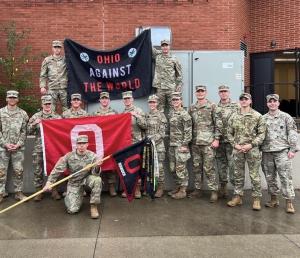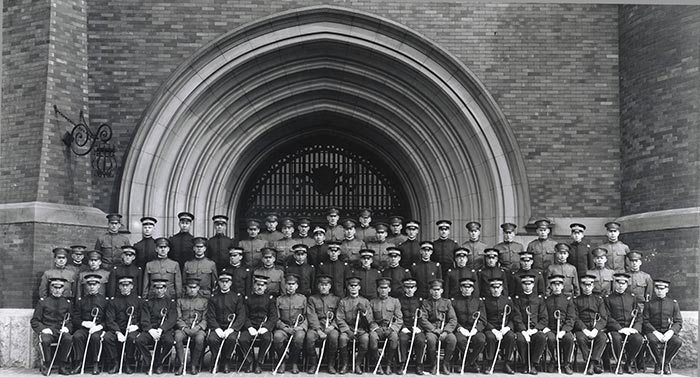History of the Program...

The mission of the Army ROTC program at The Ohio State University is to commission the future leadership for the U.S. Army and motivate young people to be better Americans. Future leaders, better citizens and military training are nothing new to those associated with Army ROTC.
From the very beginning the story of Ohio State was synonymous with the history of Army ROTC. For in 1862 The Morrill Act signed by President Lincoln (commonly referred to as the Land Grant College Act) enabled the State of Ohio to build an institution of higher learning to train young men in agricultural studies, mechanical arts and military tactics. In 1870 the Ohio Agricultural, Military, and Mechanical College opened its doors – only later to be renamed The Ohio State University.
The early formative years included mandatory studies in tactics and drill. The first recorded classes in these subjects were in 1874. Professor McFarland, a Lieutenant Colonel in the Ohio Volunteer Infantry during the American Civil War, provided first hand experience lectures on the lessons of military history, the devastation of war and the cost of military non-preparedness. Because of his influence on the universal study of military tactics, LTC McFarland is historically recognized as the first Professor of Military Science at Ohio State.
The United States Army, in 1876, formally established its presence at Ohio State by assigning active military personnel to the newly formed Department of Military Science and Tactics. Two years later, as the university graduated its first class, 2LT C.H. Dietrich became the first commissioned officer to hail from Ohio State's military program. As the years went by, both the university and its military program continued to grow.

The Patriotic verve which struck the nation during the Spanish American War did not escape The Ohio State University. A university Volunteer Company made up of the military cadre and the entire senior military science class, departed Columbus in 1898 to join the war efforts in Cuba. The Buckeye volunteers returned in a few months savoring their victorious role in history.

At the turn of the century, military science training and drill became commonplace on campus. The Professor of Military Science, COL Converse, established a structured program of study (known as the “Ohio Plan”) which became the blueprint for a nationwide program of developing military junior officers. In 1916 the Student Army Training Corps (SATC) began, forming what later was named the Reserve Officer Training corps (ROTC).
World War I brought significant changes to the ROTC program. The Department of Military Science formed a separate School for Military Aeronautics at Ohio State. This school taught aircraft design, maintenance and aerial photography for the Army Signal Corps. The school curriculum formed the basis of Aeronautical Engineering courses later taught at the university.
Traditional at Ohio State is the annual “Rock Ceremony” which traces its roots to November 11, 1919. On that date, a ceremony to honor the fallen war heroes of Ohio State took place in the university oval. Two minutes of silence, the playing of “Taps” and the laying of a wreath at the Rock outside Bricker Hall marked the occasion.
The Second World War brought increased military activity on campus. The School of Mechanical Trades and Munitions opened and a special military research grant for weapons development was awarded, and the Special Training Award of Recognition (STAR) was presented to the university. In 1943 more than 1100 students at Ohio State earned the gold bars of a lieutenant in the U.S. Army.

Following the war, Army ROTC activated branch specific training companies specializing in aeronautics, artillery, chemical defense, engineering, signal, medical and dental, transportation, armor, and ordnance. Converse Hall was also given to Army ROTC in 1948, and remains the home of ROTC on campus to this day.
The university’s Army ROTC program continued to lead the way in pursuing new opportunities for university students, as well as carving a path for nationwide programs. In 1957 the Army ROTC initiated a flight training program for its cadets. So successful was the program that the Navy and Air Force ROTC programs enrolled their midshipmen and cadets in the Army ROTC flight program. The following year, the voluntary Coed Cadet Corps was formed at the university, providing the framework for the nationwide incorporation of women into ROTC in 1973.
The United States Army in the early 1980’s decided to establish special branch affiliations with the most viable ROTC programs across the nation. Ohio State, due to a strong history of producing quality officers with engineering, maintenance and logistics experiences, was chose to be affiliated with the U.S. Army Ordnance Corps. Although associated with this Corps, the university continues to provide high quality graduates to all of the branches and specialties in the U.S. Army.
The tradition of a winning team is an ever present part of The Ohio State University and the Buckeye Battalion. The Ohio State Ranger Challenge Team (Army ROTC’s Varsity Sport) has medal placed multiple times, competing against the 38 schools under the 7th BDE US Army Cadet Command. In 2018 the Buckeye Battalion was awarded the General Douglas MacArthur Leadership award as the top performing program in 7th BDE. In 2019 the Ohio State Army ROTC Women’s Basketball team won 1st place in the national Flying Irish Basketball Tournament. A history of excellence continues to grow within the program.
The history of Army ROTC at Ohio State is long and colorful. Through the years many changes have occurred at the university and with the Military Science Program. The one constant throughout has been the high-quality college students who have accepted the challenge provided by Army ROTC. In 1996 The Buckeye Battalion added another milestone by commissioning its 10,000th lieutenant into the U.S. Army. Like the first commissionee, Lieutenant C.H. Dietrich, the cadets of today and tomorrow can stand tall and proud of their Buckeye heritage.
